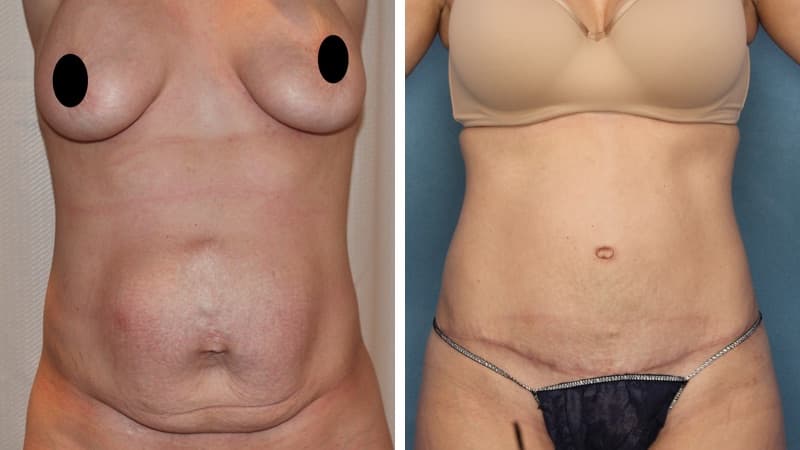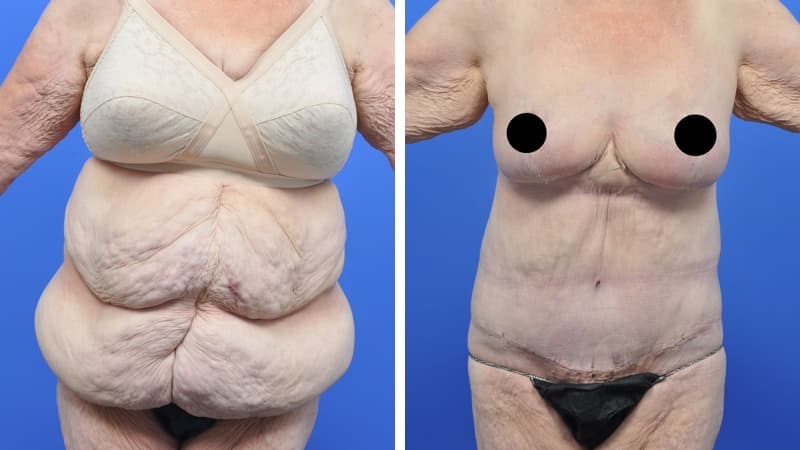The basics
If a patient has lost more than 25 kilograms, or 25% of their body weight, they are regarded as Massive Weight Loss (MWL) patients in my practice. Weight may have been lost through diet and exercise, or with bariatric (lap band or gastric sleeve) surgery, or both. It is not unusual for me to see patients who have lost up to 70 kilograms or even more. This results in massive amounts of loose skin, sometimes in unusual distributions.
It is important that patients who have lost a lot of weight before plastic surgery are identified as such, as this is an important part of safe surgical planning.
MWL patients may have nutritional issues, such as protein, iron or vitamin deficiencies. They may also have a history of diabetes or high blood pressure. Underlying cardiac disease is sometimes present and anaemia is quite common.
The skin behaves differently in MWL patients, so surgical planning and preoperative discussion must take this into account. Surgery often needs to be more extensive, or multiple, addressing more than one body area.
Finally, these operations take longer as there are more and larger blood vessels to deal with in surgery. This is because as the weight is lost, the skin and fat shrink but the blood vessels don’t. A person who used to be overweight still has the more extensive blood supply that the large areas of skin and fatty tissue needed before the weight loss. This must be carefully managed to minimise blood loss, so surgery takes longer.
What can I expect to achieve?
Plastic surgery is often needed to restore body shape after MWL. These are major operations and specific experience and knowledge in this area is required to achieve a good result.
To restore the form of the body so that normal, firm clothing may be worn, many areas may need to be addressed, including arms, thighs, abdomen, back, and breasts. Often, the face and neck do well with weight loss, but sometimes they need attention as well.
MWL patients need a rational program of surgical reconstruction, which combines procedures and minimises the number of operations in a way that patient safety and recovery are not compromised.
The patient and I work together to decide the order in which the surgery is approached. If more than one body area needs surgery, two operative sessions are usually needed, each combining several procedures.
MWL patients are usually very happy with the results of their surgery. There may be long scars in many places, but body shape is much improved, with a slimmer figure and hanging skin removed.
Note that that this type of surgery normally aims to create an excellent shape when clothed. Scars are usually quite visible when you are naked.
It’s also important to realise that skin elasticity cannot be restored, even though the excess skin is removed. This may mean that some areas of the body remain slightly loose. I will specifically discuss this with patients if it is likely to be an issue.
For MWL patients, correcting sagging skin is the last step in a long journey and finally ends years of dissatisfaction. They can now do the things most people take for granted, like buying normal clothes and exercising comfortably.
What happens before surgery?
We will organise an elastic pressure garment for you to wear when surgery is over.
If you smoke you must cease all nicotine products a minimum of two weeks before the surgery. If you’re unable to do this, the surgery will be cancelled. Complications of this surgery have been reported to be up to 40% more common in smokers, so it is not in your interest that I proceed if you’re still smoking.
Medication containing aspirin should not be taken for a minimum of 10 days before surgery. If you take any other blood-thinning medication, we will decide on a management plan before surgery.
You should have blood tests around a month before surgery, including an FBE and nutritional parameters.
We will assist with this if your GP can’t. We will also advise you on how to manage pain and constipation in the postoperative period.
For three days before the surgery, you should use a daily antibacterial wash in the shower, paying careful attention to the groin area. Products such as Phisohex, or Cetaphil, are fine and readily available from the pharmacy.
It’s important to make a good plan for recuperation, time off and getting well.
If you have a gym membership, you might want to suspend it for four to six weeks. We can provide a letter for you if you like.
Make sure you understand the procedure well and have all your questions answered before you decide to go ahead with your surgery.
What happens during surgery?
You’ll come into hospital the day of surgery and stay for a predicted time, depending on the scale of your operation. The anaesthetist will see you before surgery, and I will see you and mark you carefully.
We use a general anaesthetic. All the areas being treated are filled with local anaesthesia once you’re asleep to minimise your postoperative pain.
As these operations are quite lengthy, we take great care to minimise the risk of clots in the legs (deep vein thrombosis). We fit you preoperatively with medical grade stockings, use compression devices during the operation to keep the blood circulating through your legs, and give you a blood-thinning drug at the beginning of surgery.
Dressings and pressure garments are applied before you wake. Drain tubes may be used. You might have a urinary catheter inserted during surgery, so you don’t have to get up initially after surgery. An IV to give you fluids will be present when you wake.
You’ll wake up in the recovery room with a nurse dedicated to your care sitting next to you.
What happens after surgery?
The staff will be experienced in caring for you and managing your pain, and there will be various pain relief options on the medication chart, so the best mix of drugs can be used for you. People vary a lot in how much discomfort they have, so we plan for all scenarios.
You’ll be in hospital for some time depending on the scale of the surgery. You’ll be well taken care of in the hospitals I use.
The treated area will become swollen and bruised. The bruising gradually fades and disappears, and when your pressure garment is removed you will immediately see changes to the area. However, the swelling takes weeks to resolve, and your new shape will take time to be fully revealed. It is normal to have some permanent numbness around the scar. In hospital, the nurses will help you to get up and start walking. Over a day or two, most people can walk unassisted, but it can be longer if the surgery is really extensive.
Once you can care for yourself, eat, go to the toilet on your own, and the drain tubes are out, you’re ready to go home.
When you go home, the advice I give is to drink well, rest, and walk as much as you can. Resting is best to be stretched out like a banana, rather than sitting up. Of course, you can sit up in a chair to eat, but for the first 10 days, try to rest stretched out on the couch, recliner or bed. You’ll swell less if you do this, and it’s good for the skin.
The garment can be removed for showering, and the dressings underneath are waterproof. Otherwise, keep the garment on. You don’t need to change any dressings.
Your first postoperative appointment will be about five to seven days after you go home.
After the first 10 days you can sit as you wish.
You should avoid any exercise other than walking for about six weeks following surgery. You can resume light cardio, and begin light resisted exercise six weeks after the operation.
You can resume driving once you are comfortable, can react quickly if necessary, feel well, and are not taking strong painkillers. This usually takes around two weeks, but can sometimes be less.
At your first postoperative appointment five to seven days after you go home, we’ll tell you how you’re progressing and what to do next.
You should not plan to do anything at home other than look after yourself for the first week after you leave hospital. If you have children, you’ll need to organise complete care for the children for a minimum of the time in hospital, plus your first week at home.
After that time, you will most likely be able to participate progressively in childcare. However, for a full four weeks after the operation, the focus must be on your own recovery. Don’t hesitate to ask for assistance with other aspects of your life during this time. As you get stronger, you can do more. If you live alone, it is wise to either have a friend stay with you for the first few days you have at home, or arrange to stay with a friend or relative for that time.
If you’ve travelled to Melbourne for surgery from interstate or afar, it is wise to have a support person with you.
You’ll need time off work after surgery, depending on the size of the procedure and your occupation. We’ll discuss this before surgery.
What are the long-term effects of this type of surgery?
The lifting effect and the reduction of skin and fat are permanent. The contouring achieved by removal of excess skin and fat is also permanent.
There is always some relaxation of the skin in the first months after surgery. Sometimes, I plan to take additional lower abdominal skin out six to twelve months after surgery, to further tighten the area. I will have discussed the chances of needing to do this with you before your surgery.
Your skin and connective tissues will loosen and sag gradually as you age. If you gain weight after the surgery, the operated areas will get larger and the weight gain may reduce the quality of the result.














